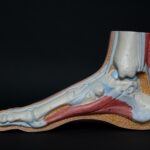Are you curious about the intricate workings of the human musculoskeletal system? Do you find yourself pondering the differences and similarities between tendons and ligaments? If so, you’ve come to the right place. In this article, we will delve deep into the world of sports medicine, exploring the fascinating realm of tendon and ligament comparison. As a highly experienced and knowledgeable orthopedic surgeon specializing in sports medicine, I am here to guide you through the complexities and nuances of these crucial structures. Brace yourself for an insightful journey into the realm of tendons and ligaments, where we will unravel the secrets and marvel at the wonders of the human body.
Tendon and Ligament Comparison
Tendons and ligaments are both crucial components of the human musculoskeletal system, playing distinct roles in connecting and supporting different parts of the body. Understanding the similarities and differences between tendons and ligaments is essential in comprehending their functions and how they contribute to our overall well-being. So, let’s dive into the fascinating world of tendons and ligaments and explore their comprehensive comparison.

Structure and Composition
Tendons and ligaments differ not only in their functions but also in their structure and composition. Tendons, which connect muscles to bones, are known for their toughness and elasticity. They consist of bundles of fiber surrounded by endotenon, providing strength and flexibility to facilitate movement. On the other hand, ligaments connect bones to other bones, providing stability to joints. Unlike tendons, ligaments have fewer fibers and more collagen, which gives them greater elasticity.
In summary, tendons are tough and elastic, primarily consisting of fiber bundles within the endotenon. Ligaments, on the other hand, have fewer fibers and more collagen, making them more elastic and crucial for joint stability.
Key Point: Tendons are tough and elastic, while ligaments are elastic and provide joint stability.
Functions and Roles
While tendons and ligaments have some similarities in their composition, their functions and roles within the body differ significantly. Tendons, being connective tissues that attach muscles to bones, transmit the force generated by muscles to allow movement. With each muscle having its own tendon, they function as essential players in our ability to bend, extend, and move different parts of our body.
Ligaments, on the other hand, connect bones to other bones, acting as reinforcements for our joints. Without ligaments, our joints would lack stability, making them susceptible to injury or dislocation. Imagine ligaments as the sturdy ropes that hold a suspension bridge in place, ensuring that the structure remains strong and intact.
Key Point: Tendons enable movement by connecting muscles to bones, while ligaments provide stability by connecting bones to other bones.
Comparing Numbers
When comparing tendons and ligaments, it’s interesting to note the difference in their distribution throughout the body. While each muscle possesses its own tendon, joints have multiple ligaments ensuring their stability. This difference illustrates the contrasting needs of our muscles and joints. Muscles require individual tendons to facilitate their specific movements, whereas joints necessitate networks of ligaments to maintain their structural integrity.
Key Point: “Each muscle has one tendon, while each joint has many ligaments.”
Wrapping it Up
In summary, tendons and ligaments are two integral components of our musculoskeletal system, each playing a unique role in connecting and supporting different parts of our body. Tendons provide the necessary force transmission for movement, while ligaments ensure joint stability. Moreover, tendons are tough and elastic, composed of fiber bundles within the endotenon, while ligaments are more elastic and possess a higher collagen composition.
Remember, understanding the differences and similarities between tendons and ligaments helps us appreciate the complexities and interconnectedness of our musculoskeletal system. It also sheds light on the importance of taking care of these structures to maintain optimal physical performance and prevent injuries.
“Tendons and ligaments: different in function, composition, and numbers, but both equally essential for our body’s strength and stability.”
For a detailed comparison between tendons and ligaments, refer to the table below:
| Tendons | Ligaments |
|---|---|
| Function: Connect muscles to bones | Function: Connect bones to other bones |
| Composition: Fiber bundles within the endotenon | Composition: Fewer fibers, higher collagen content |
| Characteristics: Tough and elastic | Characteristics: Elastic and crucial for joint stability |
| Distribution: One tendon per muscle | Distribution: Multiple ligaments per joint |
Now that we’ve explored the fascinating comparison between tendons and ligaments, we hope you have a better understanding of these crucial structures and how they contribute to our body’s functionality. So let’s keep moving, and remember to take care of your tendons and ligaments for a healthy and active lifestyle!
Tendons and ligaments are two essential components of our musculoskeletal system that often get confused due to their similar functions. However, understanding the difference between them is crucial in order to grasp their individual roles and significance. Tendons are tough, fibrous connective tissues that connect muscles to bones, enabling movement and providing stability. On the other hand, ligaments are bands of strong, elastic tissues that connect bones to other bones, supporting joints and limiting excessive movement. To delve deeper into the dissimilarities between tendons and ligaments, click here: Difference Between Tendon And Ligament
FAQ
Q: What is the main difference between tendons and ligaments?
A: Tendons connect muscles to bones, while ligaments connect bones to other bones.
Q: How do tendons and ligaments differ in terms of elasticity?
A: Tendons are tough and elastic, while ligaments are elastic.
Q: What is the difference in composition between tendons and ligaments?
A: Tendons contain bundles of fiber surrounded by endotenon, while ligaments have less fiber and more collagen.
Q: How many tendons and ligaments are associated with each muscle and joint, respectively?
A: Each muscle has one tendon, while each joint has many ligaments.
Q: What expertise does an orthopedic surgeon specializing in sports medicine provide regarding tendons and ligaments?
A: An orthopedic surgeon specializing in sports medicine possesses a thorough understanding of the complexities and nuances of the human musculoskeletal system, allowing them to provide profound insights into the comparison between tendons and ligaments.
- Unveiling Bernhard Caesar Einstein’s Scientific Achievements: A Legacy in Engineering - July 15, 2025
- Uncover who is Jerry McSorley: CEO, Family Man, Business Success Story - July 15, 2025
- Discover Bernhard Caesar Einstein’s Scientific Contributions: Unveiling a Legacy Beyond Einstein - July 15, 2025















